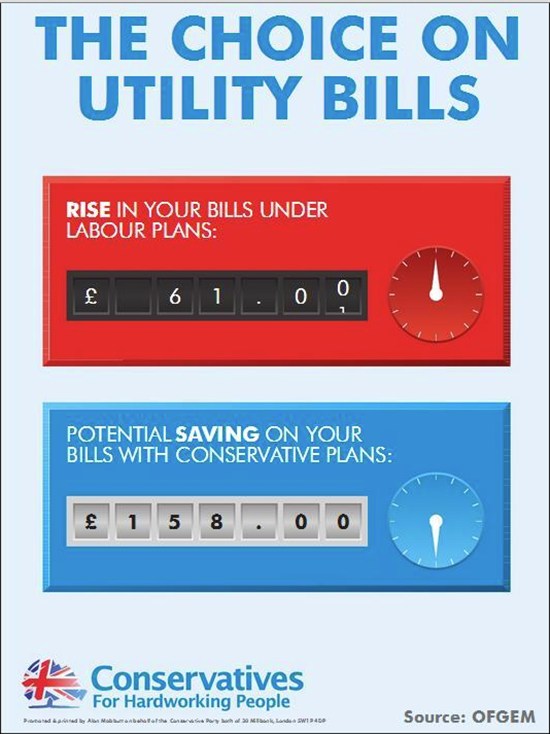Robin Webster
03.06.2013 | 6:00pmVoting Labour could mean a rise in consumer energy bills of £61, while voting Conservative could mean a potential saving of £158, according to a Conservative party ad. But on closer inspection, it’s a bit more complicated than that.
Conservative party chairman Grant Shapps MP tweeted a new ad from Conservative Campaign Headquarters (CCHQ) this morning:
In an article today, the Conservative Home blog says:
“[The ad] â?¦ point[s] â?¦ to a stark choice: an immediate £61 rise in your energy bills under Labour’s current plans versus a “potential saving” of £158 under the Conservatives.”
Let’s take a look at each claim.
A £61 rise under Labour?
The first claim lies with Labour leader Ed Miliband’s opposition to reducing state support for large solar installations back in 2011.
Miliband signed a parliamentary petition opposing reform to Feed in Tariffs (FiTs). A press release from CCHQ says:
“…Miliband has already pledged to add £61 immediately to your energy bills by opposing solar subsidy reform. Miliband signed an early day motion opposing our reforms to solar subsidies. These reforms have saved households £61 on their energy bills”.
FiTs provide financial support for small-scale generation of electricity – often from solar panels on householder’s roofs. Miliband introduced the scheme in 2010 when he was energy secretary.
But FiTs were more successful than the government expected, meaning the cost of the scheme ran out of control. The current government fought a lengthy battle to bring down the subsidy levels and reduce the cost of the scheme.
The Department of Energy and Climate Change (DECC) predicted in 2012 that if it hadn’t reformed FiTs, the costs would have continued to increase, adding £61 to householders’ bills by 2020. By contrast, it suggested after the reforms £9 a year will be added to bills by 2020.
So in theory the number the Conservatives should have used is £52 (not £61), as £9 is predicted to remain. But that’s assuming that Miliband’s opposition to the FiT review two years ago implies that Labour would have refused to make any changes at all to the scheme up to 2020.
It also means ConHome’s characterisation of the purported savings as “immediate” isn’t accurate, as the estimated increase in energy bills refers to 2020 – not now.
A £158 saving if you vote Conservative?
Moving on to the claim that voting Conservative will save householders £158 on their energy bill.
This stems from October 2012 when Prime Minister David Cameron announced, apparently out of the blue, that the government would force energy companies to put their customer onto the cheapest possible tariff.
This seemed to surprise everyone – including DECC. But a month later the department produced a policy to fit Cameron’s announcement. In a new measure included in the energy bill, energy companies will only be able to offer four energy tariffs to consumers, starting from 2014.
DECC’s plan was based on a proposal from energy regulator Ofgem – which at the time of Cameron’s announcement was still an unpublished draft. In its analysis, Ofgem suggests:
“Consumers can save an average of £72 and a possible maximum of £158 per year by switching to the cheapest deal in the market for their payment method”.
So the figure of £158 refers to the maximum amount of money that consumers could save now – if they seek out the cheapest deal. But it is also an upper estimate, and clearly wouldn’t apply to every household.
Comparing like with like?
The Conservative Party’s press release also highlights other potential areas where Labour’s plans could add more to bills than its own. It argues that Labour’s plan to force energy suppliers to pool the power they generate and auction it off would force bills up rather than down, for example. But it doesn’t give any figures for that.
The figures in the graphic tweeted by Shapps perhaps highlight the danger of oversimplifying matters. They aren’t really comparable and give no sense of the huge diversity of factors that affect energy bills.
It would almost certainly be possible to pluck two stats from the energy debate of the past few years to show the opposite effect. We’ll leave that as an exercise for the reader, but it really just shows that it would probably be more helpful for everyone – especially voters – if such interventions remembered that it’s usually a bit more complicated.


